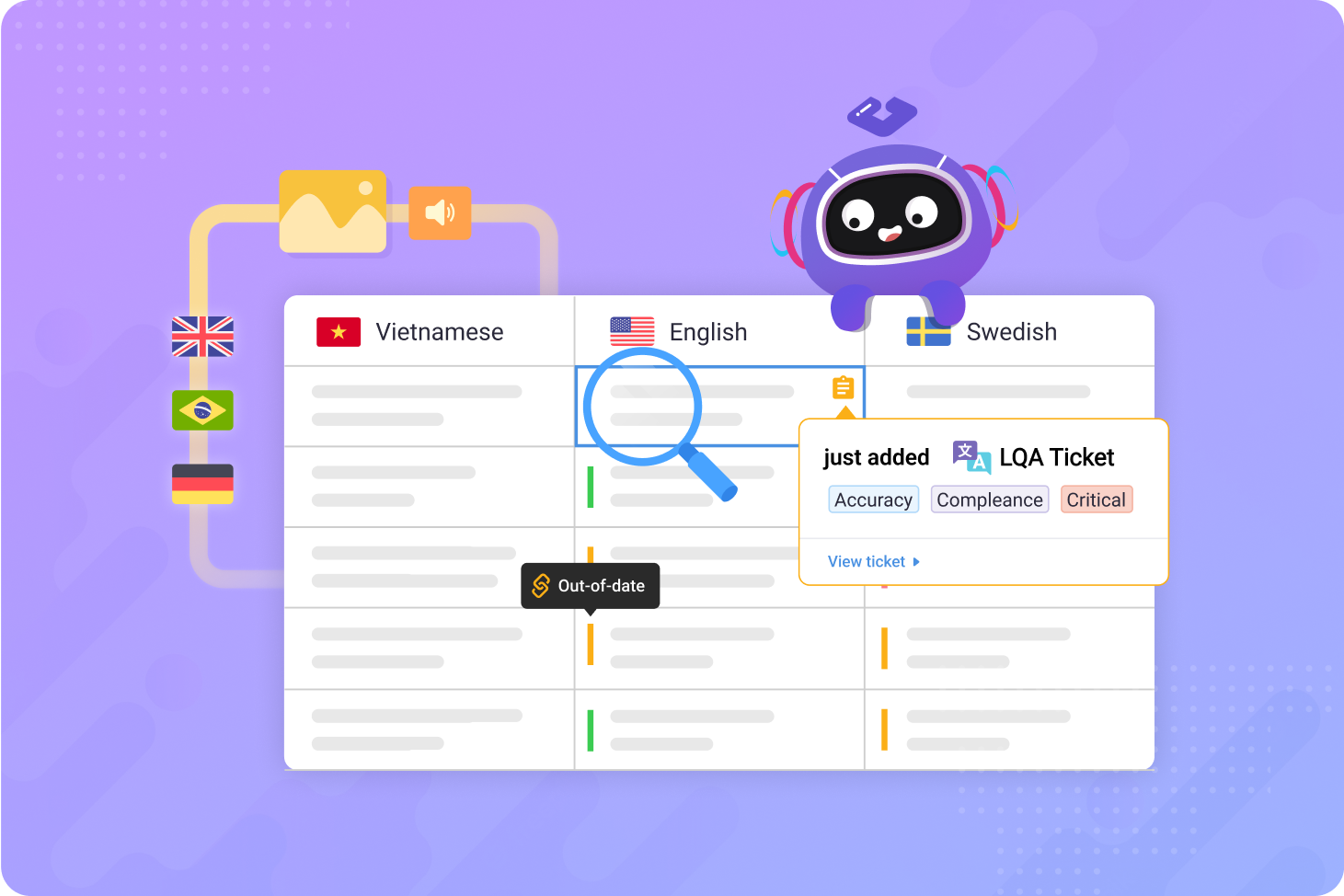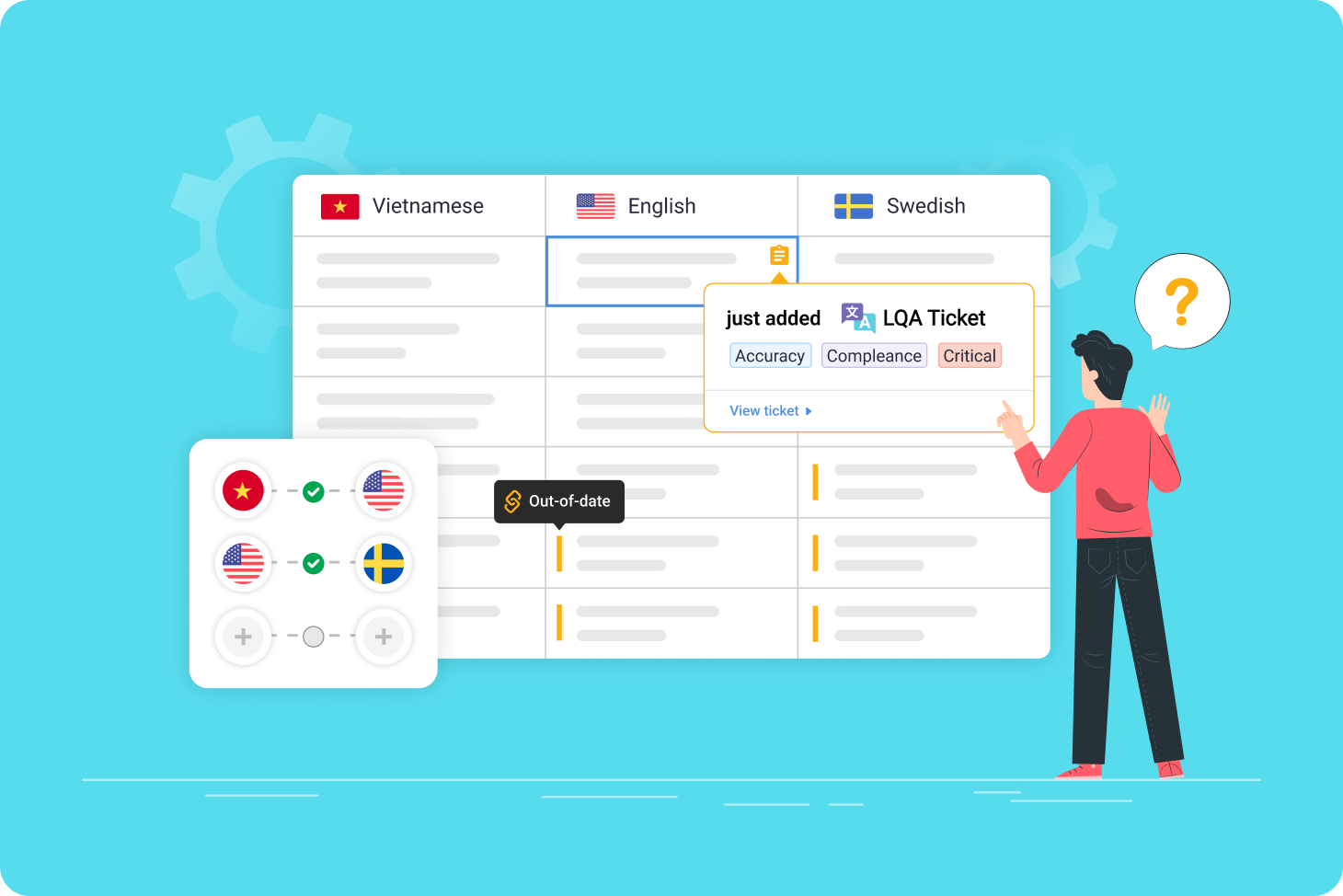What is automated localization QA?
Automated localization quality assurance is the process of using computer software to perform various aspects of the localization testing process. Automated LQA frees your testing team to focus on more complex tasks while leaving the repetitive aspects of testing to your software tools.
>> Learn more about localization QA
Should you automate the entire localization testing process?
Localization testing is a broad practice that covers multiple disciplines and types of quality checks. While some can be automated, others require the attention and expertise of a trained linguist. Automating the entire testing process can result in an overall quality loss if you aren’t having your translated strings checked by professionals.
When should you use automated localization QA?
Just like when it comes to the choice between machine translation and human translators, automated LQA is best left for simpler, more mundane testing that isn’t reliant on language or regional expertise. Functional issues, missing translations, and other similar problems are ideal candidates for automation.
- Correct language display: Automated testing tools can change a user’s language preferences and verify that the correct language is displayed.
- Navigation: Navigation testing checks to make sure all buttons and links work properly in each language. Automated browser-based tools can navigate your localized website in seconds.
- Untranslated text: Specialized content management platforms built for localization will automatically detect whether a given text string has been translated or not.
>> Learn more about managing content for localization
- Screenshot collection: You’ll want human testers to verify that all your text strings are displayed correctly — whether they fit in their designated fields, or if they’re appearing in the right place. Automated tools can collect screenshots for your testers to review.
- Form verification: Automated tools can check whether forms on your website function correctly and deliver the submitted information to the right place.
- Smoke testing: Smoke testing is an initial testing phase that looks for severe errors that prevent your product from working properly.
- Payment processing: One part of functionality testing is checking whether local payment methods are correctly implemented. Here, automation can help.
Which parts of the LQA process should be performed manually?
Only a trained language professional can evaluate translations for accuracy and consistency. And you’ll want to trust regional experts to make sure your localized content meets local regulations.
- Linguistic integrity: Machine translation isn’t yet on part with human professionals. Entrust your translation checks to a human.
- Brand tone and voice consistency: Regional branding experts can assess whether your localized content successfully channels your brand in your target markets.
- Text and font display issues: Use an automated tool to collect screenshots, then have human testers review them for display issues.
- Legal and regulatory compliance: Is your data protection appropriate for each region? How about your marketing claims? Only a local legal expert can verify this for sure.
- Cultural analysis: A software tool won’t know whether you’re breaking any regional taboos or using culturally meaningful images and expressions.
What are the benefits of automated localization QA?
Automated localization QA can significantly speed up your localization testing process while ensuring a higher overall degree of quality.
Efficiency
As deadlines loom, it can be tempting to rush or waive LQA in favor of a quicker launch. Automation can free your testers from the repetitive, time-consuming tasks that bog down the overall LQA process.
Without automated QA tools, localization testers would have to play a game in its entirety to verify that all text strings are displayed correctly. The advent of automated screenshot collection changed that. Now, rather than waste time playing a game, testers can simply review screenshots of each string as it appears in a game.
The proof is in the numbers: Angry Birds developer Rovio enjoyed a fourfold increase in testing speed with a simple Unity script that automatically collected screenshots and imported them into Gridly. Testers no longer needed to play through the game themselves or view screenshots in a separate folder.
Fewer errors
Automated QA tools will find every instance of untranslated text, broken functionality, or incorrect code. And without the drudgery of repetitive tasks dragging them down, your testing team will be less fatigued and more focused when it comes to the other aspects of LQA.
Better performance
An automated testing tool can run through your localized app or game in seconds, verifying every link, button, and form in a fraction of the time it’d take a human tester to do the same. The same goes for translation completion — when your localization management platform automatically detects new content, you’ll always know if your translators missed a string.
Anchor your LQA process to the right platform
As a content management platform built with localization in mind, Gridly is designed to optimize the entire pipeline — including localization QA. Native support for a wide range of LQA models enables your testers to precisely classify issues and automatically forward them to the right teammates for follow-up.
Use Gridly’s multimedia file support to import screenshots right next to the relevant strings so your testers can check everything in one place. Meanwhile, automatic status tracking identifies untranslated strings to ensure you don’t have any incomplete translations pushed into your project.
That’s just a quick look at how Gridly can automate your LQA workflow to save time and boost the finished quality of your product. Ready to learn more?
>> Discover all the ways Gridly can augment your localization workflow
>> Find out more about Gridly’s localization-boosting features









